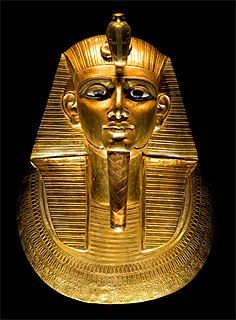| Menkheperre in hieroglyphs | |||||
|---|---|---|---|---|---|
| |||||
Menkheperre was an ancient Egyptian theophoric name. Its notable bearers were:

Ancient Egypt was a civilization of ancient North Africa, concentrated along the lower reaches of the Nile River in the place that is now the country Egypt. Ancient Egyptian civilization followed prehistoric Egypt and coalesced around 3100 BC with the political unification of Upper and Lower Egypt under Menes. The history of ancient Egypt occurred as a series of stable kingdoms, separated by periods of relative instability known as Intermediate Periods: the Old Kingdom of the Early Bronze Age, the Middle Kingdom of the Middle Bronze Age and the New Kingdom of the Late Bronze Age.
A theophoric name embeds the name of a god, both invoking and displaying the protection of that deity. For example, names embedding Apollo, such as Apollonios or Apollodorus, existed in Greek antiquity.
- Menkheperre Thutmose III, pharaoh of the 18th Dynasty;
- Menkheperre, prince, son of Thutmose III;
- Menkheperre, Theban High Priest of Amun during the 21st Dynasty;
- Menkheperre Ini, pharaoh of the Third Intermediate Period;
- Menkheperre Necho I, pharaoh of the 26th Dynasty.

Pharaoh is the common title of the monarchs of ancient Egypt from the First Dynasty until the annexation of Egypt by the Roman Empire in 30 BCE, although the actual term "Pharaoh" was not used contemporaneously for a ruler until Merneptah, c. 1200 BCE. In the early dynasty, ancient Egyptian kings used to have up to three titles, the Horus, the Sedge and Bee (nswt-bjtj) name, and the Two Ladies (nbtj) name. The Golden Horus and nomen and prenomen titles were later added.
Menkheperre was a prince of the Eighteenth Dynasty of Egypt, one of two known sons of Pharaoh Thutmose III and his Great Royal Wife Merytre-Hatshepsut. His name is the throne name of his father and means “Eternal are the manifestations of Re”.
While not regarded as a dynasty, the High Priests of Amun at Thebes were nevertheless of such power and influence that they were effectively the rulers of Upper Egypt from 1080 to c. 943 BC, after which their influence declined. By the time Herihor was proclaimed as the first ruling High Priest of Amun in 1080 BC—in the 19th Year of Ramesses XI—the Amun priesthood exercised an effective stranglehold on Egypt's economy. The Amun priests owned two-thirds of all the temple lands in Egypt and 90 percent of her ships plus many other resources. Consequently, the Amun priests were as powerful as the Pharaoh, if not more so. One of the sons of the High Priest Pinedjem I would eventually assume the throne and rule Egypt for almost half a decade as pharaoh Psusennes I, while the Theban High Priest Psusennes III would take the throne as king Psusennes II, the final ruler of the Twenty-first Dynasty of Egypt.
People with a very similar name were:
- Menkheperraseneb I, High Priest of Amun during the 18th Dynasty;
- Menkheperreseneb II, High Priest of Amun during the 18th Dynasty;
- Menkheperure Thutmose IV, pharaoh of the 18th Dynasty.

Menkheperraseneb I was a high official under the reign of king (pharaoh) Thutmose III and Amenhotep II. He was a High Priest of Amun and therefore the most important religious official in his days.

Menkheperreseneb II was a High Priest of Amun, Superintendent of the Gold and silver treasuries, and Chief of the Overseers of Craftsmen. He served at the time of Thutmose III and Amenhotep II, and may have been buried in his Theban tomb, TT112.

Thutmose IV was the 8th Pharaoh of the 18th dynasty of Egypt, who ruled in approximately the 14th century BC. His prenomen or royal name, Menkheperure, means "Established in forms is Re."
| This page or section lists people that share the same given name. If an internal link led you here, you may wish to change that link to point directly to the intended article. |
| This article about Egyptology or subjects relating to Ancient Egypt is a stub. You can help Wikipedia by expanding it. |








